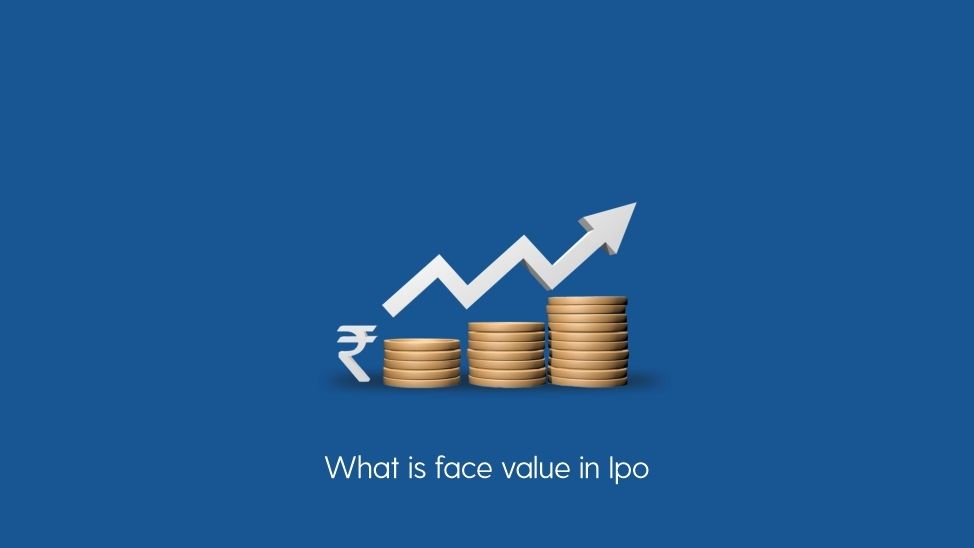What is Face Value in IPO?

- Published Date: October 24, 2025
- Updated Date: November 28, 2025
- By Team Choice
If you’ve ever explored investing in the stock market or tracked an upcoming IPO, you’ve likely come across the term face value. Many new investors wonder: What is face value in IPO, and why does it matter?
In this blog, we will simplify the concept of what is face value in IPOs, covering its definition, relevance, and calculation so investors can make informed decisions.
What Does Face Value Mean in an IPO?
Face value in the share market refers to the original value assigned to a share by the company when it is issued. Also known as par value or nominal value, it represents the base price of a share and is independent of its market price or the IPO issue price.
For example, if a company issues shares with a face value of ₹10, each share is considered to be worth ₹10 on paper, regardless of how much investors are willing to pay during the IPO or on the stock exchange later.
Face value is important because it forms the foundation for various financial calculations, such as dividends, stock splits, and determining the total share capital of the company. Understanding it helps investors make sense of the company’s financial structure before investing in an IPO.
Relevance of the Face Value in IPOs
Face value plays a key role in understanding a company’s shares during an IPO. While it may not reflect the market value or issue price, it is essential for several financial and investment decisions. Here’s why:
1. Determines Share Capital:
The total capital a company raises during an IPO is calculated using the face value:
Total Capital = Face Value × Number of Shares Issued
This helps investors and regulators understand the company’s equity structure.
2. Basis for Dividends:
Dividends are often declared as a percentage of face value, not market price. For example, a 20% dividend on a ₹10 face value share means ₹2 per share, regardless of the trading price.
3. Linked to Issue Price:
Evaluating the issue price vs face value factors determines whether the shares are issued at a premium or discount. Understanding this helps investors gauge how much they are paying over the nominal value of shares in an IPO.
4. Useful for Financial Metrics:
Face value is used in calculating important ratios like earnings per share (EPS) and helps assess returns on equity (ROE) for both new and existing investors.
How to Calculate the Face Value of Shares?
Understanding how to calculate the face value shares is simple. Use the following formula:
Face Value = Equity Share Capital ÷ Total Number of Shares Issued
- Equity Share Capital: The total capital raised by the company through equity shares.
- Total Number of Shares Issued: The total number of shares the company has issued to investors.
Example:
If a company raises ₹50 lakh as equity share capital and issues 5 lakh shares, the face value of each share will be:
Face Value = ₹50,00,000 ÷ 5,00,000 = ₹10 per share
Knowing how to find face value helps investors evaluate estimated dividends and assess the company’s total capital structure before investing in an IPO.
Difference Between Face Value and Market Value
Understanding the difference between face value and market value is crucial for investors navigating IPOs and the share market. While both terms relate to a share’s value, they serve very different purposes.
| Particulars | Face Value | Market Value |
|---|---|---|
| Meaning | The nominal value assigned to a share by the company at issuance. | The current price of a share as traded on the stock exchange. |
| Price Determination | Set by the company when issuing shares. | Determined by market forces such as demand, supply, corporate performance, and investor sentiment. |
| Price Fluctuations | Remains constant unless the company does a stock split or consolidation. | Continuously changes based on market conditions, macroeconomic factors, and global events. |
| Calculation | Equity Share Capital ÷ Number of Shares Issued | Current Market Price × Number of Outstanding Shares |
Additionally, while face value helps in calculating dividends and share capital, market value reflects the actual price investors pay for shares in real-time. A related concept is book value, which is the net asset value per share (total assets minus liabilities divided by the number of issued shares).
Final Thoughts
Understanding face value in IPOs is essential for both new and seasoned investors. It also plays a key role in decisions related to stock splits, corporate reporting, and financial ratios. For anyone tracking upcoming IPOs, participating in book building, or analysing shares, knowing the face value ensures you have a clear grasp of a company’s financial structure and helps make informed investment choices.
FAQs
1. What is the face value in the share market?
Face value means the original nominal value of a share set by the company. It remains unchanged unless the company restructures its shares.
2. How do you calculate the face value of a share?
Face value is calculated by dividing total equity share capital by the number of issued shares. Most often, it is directly listed in company documents.
3. What is the difference between face value and market value?
The company fixes the face value. The market value of a security is influenced by factors such as demand and supply, the company’s performance, and overall investor sentiment.
4. How can I find the face value of a stock?
Check the company’s DRHP, balance sheet, stock exchange filings, or financial platforms.
5. What are the key differences between face value and issue price?
- Face Value: Nominal price assigned to a share.
- Issue Price: The price at which shares are offered to the public in an IPO (includes premium).
Recommended for you

Covered Call Strategy Explained

FII DII Data - Live Data

Share Market Prediction For Tomorrow
